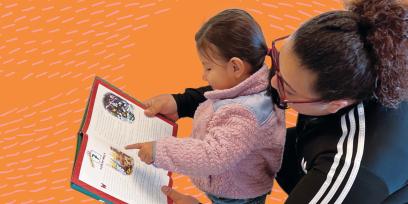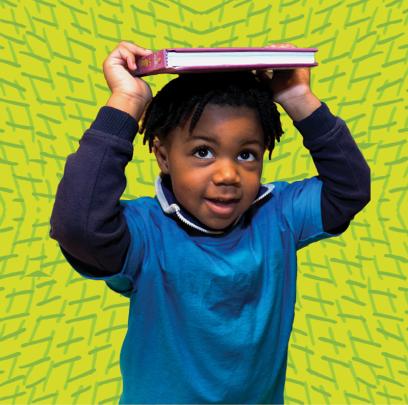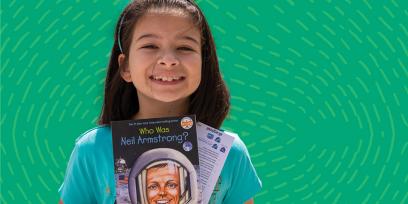Although the focus in the early grades is often on teaching young children how to read, the ultimate goal of reading is to understand the text—whether to learn new information or simply enjoy a story. Building the groundwork needed for this understanding starts right from the beginning of life—and it’s essential from the beginning of school. What kind of instruction should you be looking for in your child’s classroom?
During the primary grades (kindergarten through second grade), teaching children to sound out words is a necessary focus of instruction.1 Teachers should intentionally and carefully help children understand the relationships between written letters and spoken sounds. As children practice sounding out words in the texts they are reading, their ability to read words grows. Their understanding grows too because being able to quickly recognize words makes it easier to focus on the meaning of the texts. (See the article by Nell K. Duke for information on how to support foundational reading skills.)
But teaching children how to sound out words is not enough to help them become skilled readers. It is important that early instruction also focuses on language comprehension, especially understanding written language when it is read aloud.2
What Does Language Comprehension Include?
Vocabulary: the words that children can either understand or use. As children become readers, they will be expected to understand words that typically are not used in everyday household conversations—but are used in books.3 Therefore, exposing children to the language of books early on is important.
Language structures: the ways that words come together to form sentences and sentences come together to form paragraphs. Just as the words used in everyday conversations are different from the words in written language, the structure of language is different when speaking than when writing. Written sentences tend to be much longer and more complex.
Verbal reasoning: the ability to make sense of what you are reading. An important part of this is making inferences, or “reading between the lines.” Consider the following sentences from the book Knuffle Bunny Too,4 when Trixie realized in the middle of the night that her toy was switched with a classmate’s toy: “Trixie marched into her mommy and daddy’s room and said: ‘That is not my bunny.’ Trixie’s daddy … asked, ‘Can we deal with this in the morning?’ Trixie’s daddy went to the phone.” To make sense of these sentences, the reader or listener must infer that although Trixie’s daddy wanted to sleep, he felt pressure from his daughter to immediately take care of the situation by calling her classmate’s parents.
Background knowledge: the information that the reader or listener needs to understand the text. In the Knuffle Bunny example, children would need some knowledge of what it feels like to be in Trixie’s situation to fully understand the urgency she felt to get her toy back. Because there is so much knowledge that children need and because it takes time to build, it is important that science and social studies instruction are emphasized in the earliest grades. In later grades, when children are expected to read science and social studies textbooks (and as adults, when they want to read newspapers), they will rely on this knowledge to be able to understand and learn from these more challenging texts.
Why Does Language Comprehension Matter?
Sometimes parents are surprised to learn that their child has difficulty understanding what they read in the upper elementary grades because teachers hadn’t mentioned a reading problem in the primary grades. This might happen because the kinds of texts that children are expected to read change dramatically over time. In kindergarten and first grade, children are reading simple texts that are often fictional stories. By fourth grade, children spend a lot of time independently reading complex informational texts, such as a biography in social studies or a science textbook.
Take, for example, this excerpt from the book Rocks and Minerals:
Meteorites are pieces of rock or metal that hit the Earth. Some have broken off asteroids, large chunks of rock that orbit the Sun between Mars and Jupiter. Most are fragments of comets.5
To understand this passage, children must already have some familiarity with most of the vocabulary, especially words that are not defined, like fragments and comets. They must be able to understand the structure of the sentences—for example, understanding that the definition of asteroids comes after the comma. They must also have some background knowledge about the solar system and how it works. The next sentence in the book talks about how a massive meteorite may have caused the dinosaurs to become extinct. To understand how that is possible, an inference is necessary—children must understand something about how a big meteorite could damage the Earth or its atmosphere.
In a simple passage about meteorites, there is a lot to understand! The good news is that, in partnership with your child’s teacher, you can help develop your child’s language comprehension.
How Should K–2 Instruction Address Language Comprehension?
Back-and-forth conversation: From birth, children are developing language through conversations. This doesn’t stop when they enter school. Teachers should foster a classroom in which your child has an opportunity to participate in frequent conversations on stimulating topics. As teachers engage children in back-and-forth conversations, they extend children’s ideas to help them learn new words and knowledge.6
Interactive read-alouds: Interactive read-alouds are a great way to foster language comprehension,7 especially when children are listening to books that are a few grade levels above what they can read by themselves. With conversations before, during, and after these read-alouds, children can really learn from what they hear. The types of texts that teachers choose also matters. For example, when teachers choose several texts on the same topic (e.g., the water cycle), children’s knowledge and vocabulary can grow.8
Vocabulary instruction: It is important for teachers to carefully select vocabulary words from the read-alouds. They should provide instruction on these words in which they share child-friendly definitions, help children connect new words to words they already know, and encourage children to use the words.9 (Ask your child’s teacher to share vocabulary words regularly so you can practice them at home too.) Teachers should also foster learning environments where children are curious about words and the world.
Content knowledge instruction: Children should spend time learning about science and social studies topics in deep and meaningful ways. Read-alouds are important, but children should also spend time writing about and discussing these topics, along with engaging in hands-on inquiry (e.g., science investigations).10
Comprehension strategy instruction: Teachers can teach important strategies that help children learn to read for understanding.11 For example, a teacher can help students monitor their comprehension during a read-aloud, stopping to think aloud about whether what was just read made sense. They can also model summarizing what they just learned from a particular page or paragraph.
Be on the lookout for how your child’s language comprehension is supported right from the start of schooling. Your child’s teacher should engage the class in meaningful conversations, provide experiences with listening and responding to a variety of texts, teach vocabulary words, and systematically build science and social studies knowledge. These opportunities to learn during the early years lay important groundwork for later reading success.
Sonia Q. Cabell is an associate professor of reading education with the School of Teacher Education and the Florida Center for Reading Research at Florida State University.
Endnotes
1. L. Ehri, “What Teachers Need to Know and Do to Teach Letter-Sounds, Phonemic Awareness, Word Reading, and Phonics,” The Reading Teacher 76, no. 1 (2022): 53–61.
2. H. Scarborough, “Connecting Early Language and Literacy to Later Reading (Dis)Abilities: Evidence, Theory and Practice,” in Handbook of Early Literacy Research, ed. S. Neuman and D. Dickinson (New York: Guilford, 2001).
3. A. Cunningham and K. Stanovich, “What Reading Does for the Mind,” American Educator 22, nos. 1–2 (Spring/Summer 1998): 8–15.
4. M. Willems, Knuffle Bunny Too (New York: Hyperion Books for Children, 2007).
5. C. Bingham, Rocks and Minerals (New York: DK Publishing, 2004), 16.
6. S. Cabell et al., “Teacher-Child Conversations in Preschool Classrooms: Contributions to Children’s Vocabulary Development,” Early Childhood Research Quarterly 30A (2015): 80–92.
7. T. Zucker et al., “The Role of Frequent, Interactive Prekindergarten Shared Reading in the Longitudinal Development of Language and Literacy Skills,” Developmental Psychology 49, no. 8 (2013): 1425–39.
8. T. Wright et al., “The Impact of Knowledge-Building Through Conceptually-Coherent Read Alouds on Vocabulary and Comprehension,” Reading Psychology 43, no. 1 (2022): 70–84.
9. I. Beck, M. McKeown, and L. Kucan, Bringing Words to Life: Robust Vocabulary Instruction, 2nd ed. (New York: Guilford, 2013).
10. H. Hwang et al., “What Research Says About Leveraging the Literacy Block for Learning,” Reading in Virginia 42 (2021): 35–48.
11. N. Duke, A. Ward, and P. D. Pearson, “The Science of Reading Comprehension Instruction,” The Reading Teacher 74, no. 6 (2021): 663–72.
[photos: AFT]



